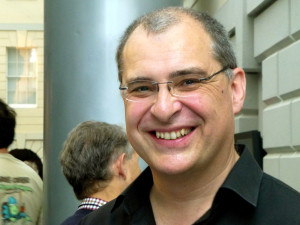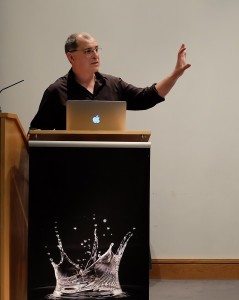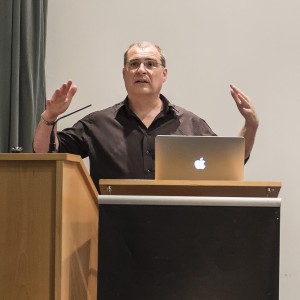May 20, 2013
Solar Observing
Pete Lawrence
Report by: Mike Meynell
The Flamsteed were privileged to welcome Pete Lawrence from the BBC Sky at Night presenting team for what proved to be a superb lecture on Solar Observing. Pete visited Greenwich in January when “The Sky at Night” came to film a special programme about our nearest star, the Sun. Not wanting to let an opportunity pass, we approached Pete about giving a talk to the Flamsteed and we were delighted when he enthusiastically accepted.
Apart from his regular appearances on the television, Pete is very well known as an astro-photographer, producing some stunning images of solar system objects, including some incredible high-resolution images of the Sun.
Pete started by giving us an overview of what the Sun actually is. At 93 million miles from Earth, it may be our nearest star but is still a very long way off. However, as it is 900,000 miles in diameter, we can see a huge amount of detail on the surface. Energy from the Sun comes from the process of nuclear fusion, with a resultant mass loss of 4.3 million tonnes per second. The Sun is in a state of hydrostatic equilibrium, with the inward gravitational pressure being balanced by the outward thermal and radiation pressure.
The Sun is made up of a number of layers, with the core surrounded by a radiative zone (where energy is transferred by thermal radiation) and then the outer convective zone (where energy is transferred by thermal convection). The visible surface of the Sun is known as the ‘photosphere’ and allows us to see the tops of these convective cells, which we term ‘solar granulation’. Sunspots are regions within the solar granulation that look dark, caused by the twisting of magnetic fields in the Sun as a result of differential rotation. Convection is inhibited as a result, meaning that these areas cool by around 1,500°C in comparison to the surrounding area and therefore appear dark when viewed from the Earth. The temperature of these areas, however, is still around 4,000°C.
Sunspot activity waxes and wanes on an approximate 11-year cycle. Detailed observations of sunspots were undertaken by the Royal Greenwich Observatory from 1874 to 1976, after which the data has been provided in the same format by the USAF/NOAA.
Pete then talked about techniques for observing the Sun safely. He started by explaining that (apart from a falling asteroid!) the Sun is the only astronomical object that can cause you harm. You must never look directly at the Sun (or via a telescope or binoculars) without a proper filter.
The first technique discussed was that of solar projection: taking a telescope and pointing it at the Sun, projecting the image from the eyepiece on to a piece of paper. Pete wasn’t keen on this method for two reasons. Firstly, it cannot be done with all telescopes… it should only be done with a small refractor (even then there are problems, as Pete melted one of his eyepieces using this method!). Secondly, unless the telescope is continually supervised, there is always the danger of somebody mistakenly looking through the scope with disastrous consequences.
The better alternative is to use astro solar film, which comes in two types: ND 3.8 for imaging and ND 5.0 for visual use. These are known as ‘white-light filters’ and they come in sheets that can be fitted to the front of the telescope to make sure the entire aperture is covered. Pete has made an excellent video, which is still available on the BBC website, which shows how to make a solar filter using astro solar film. One thing to remember when fitting a solar filter to your telescope is the finder-scope. This should be removed, covered or fitted with a solar filter. Pete recounted a story told by Patrick Moore, about a friend who forgot about the finder-scope when doing solar observing and ended up setting light to his beard!
White-light filters allow you to see the photosphere of the Sun, along with details of any sunspots, showing both the umbra and penumbra. It is also possible to see ‘limb darkening’ on the edge of the Sun, a phenomenon caused by the reduced density and temperature near the surface of the Sun. This darkening allows you to see faculae, which are bright areas in this region.
It is possible to see solar flares in white light, though it is very rare. The most famous of these was the one seen by Richard Carrington in 1859, an event brilliantly described by Stuart Clark in his lecture to the Flamsteed in January 2009.
Solar flares can produce coronal mass ejections, which, if they impact the Earth’s magnetosphere, produce displays of aurora as a result of the geomagnetic storm. Strong geomagnetic storms allow aurora to be seen at lower altitudes, but they are most commonly seen in Polar Regions.
Pete moved on to talk about viewing the Sun’s chromosphere. One way to view this is during a solar eclipse, when it is possible to see the reddish colour of the chromosphere at the point of totality. Another alternative is to view the Sun using a very narrow bandwidth filter, centred on the Hydrogen Alpha (“H-alpha”) spectral line (656.281nm). In the chromosphere, H-alpha light is emitted, absorbed and re-emitted, meaning that it is possible to see details within the chromosphere with a filter tuned to this wavelength.
The solar granulation that can be seen in white light is not visible in H-alpha. Instead, the Sun takes on the surface appearance of an orange, with dark mottles visible. Sunspots are not as impressive in H-alpha in comparison to white-light, but it is possible to view prominences and filaments (which are the same as prominences, but viewed against the Sun’s disc rather than on the edge), held above the solar surface by the Sun’s magnetic field. Around sunspots, it is possible to see fibrils and plages.
Pete talked about the various types of prominences that can be seen on the edge of the Sun. One of the rarest types is a ‘post-flare loop’, which are formed after a solar flare. Flares are more commonly visible in H-alpha light, when compared to white-light.
There are a number of specialist H-alpha telescopes available, designed purely for looking at the Sun. It is also possible to buy a special kit to convert a night-time telescope for H-alpha viewing. The scopes tend to be quite expensive, particularly for larger filters, because the manufacturing of the etalon filter requires great precision.
It is possible to buy telescopes that can view the Sun in other wavelengths, Calcium-K being the most common. These scopes are difficult to use visually, as the wavelength is in the blue part of the visible spectrum. However, they can be successfully used with imaging set-ups, and can show the plage regions visible right across the Sun’s disc.
Despite being on his feet for nearly an hour, Pete moved on to talk about imaging the Sun… a topic that was of great interest to the many keen astro-photographers present in the audience.
DSLR cameras are great all-round tools, and can be used to great effect for sunrise and sunset shots. However, you must make sure the Sun is very low down in the sky in order to prevent damaging your equipment. A very interesting effect to look out for is the ‘green flash’, an optical phenomenon visible for only a few seconds.
Using a DSLR camera attached to a H-alpha telescope can be done, but there are problems due to the Bayer filter used in most DSLR cameras, which means that only 25% of the red light (which makes up most of a H-alpha image) is registered by the camera sensor. As a result, Pete normally uses a high-frame rate planetary camera with a monochrome (grey-scale) chip and adds the colour back in post-processing (using Photoshop or an equivalent photo-processing program). The high-frame rate camera allows you to pick frames where the seeing conditions are good. These images can be stacked in a program, such as Registax, to give a sharp and crisp image.
Pete recommends that the best time to take images of the Sun is in the early to mid-morning, before the heat of the Sun causes turbulence in the atmosphere, affecting the seeing conditions.
Pete covered a huge amount of ground during this fascinating lecture. We are very grateful to him for giving up his precious time to come and see us.
Pictures from the Evening (by Grey Lipley and Mike Meynell):
Posted under: Flamsteed, Flamsteed Lecture, Meeting Report















You must be logged in to post a comment.